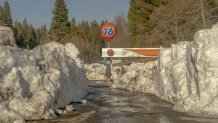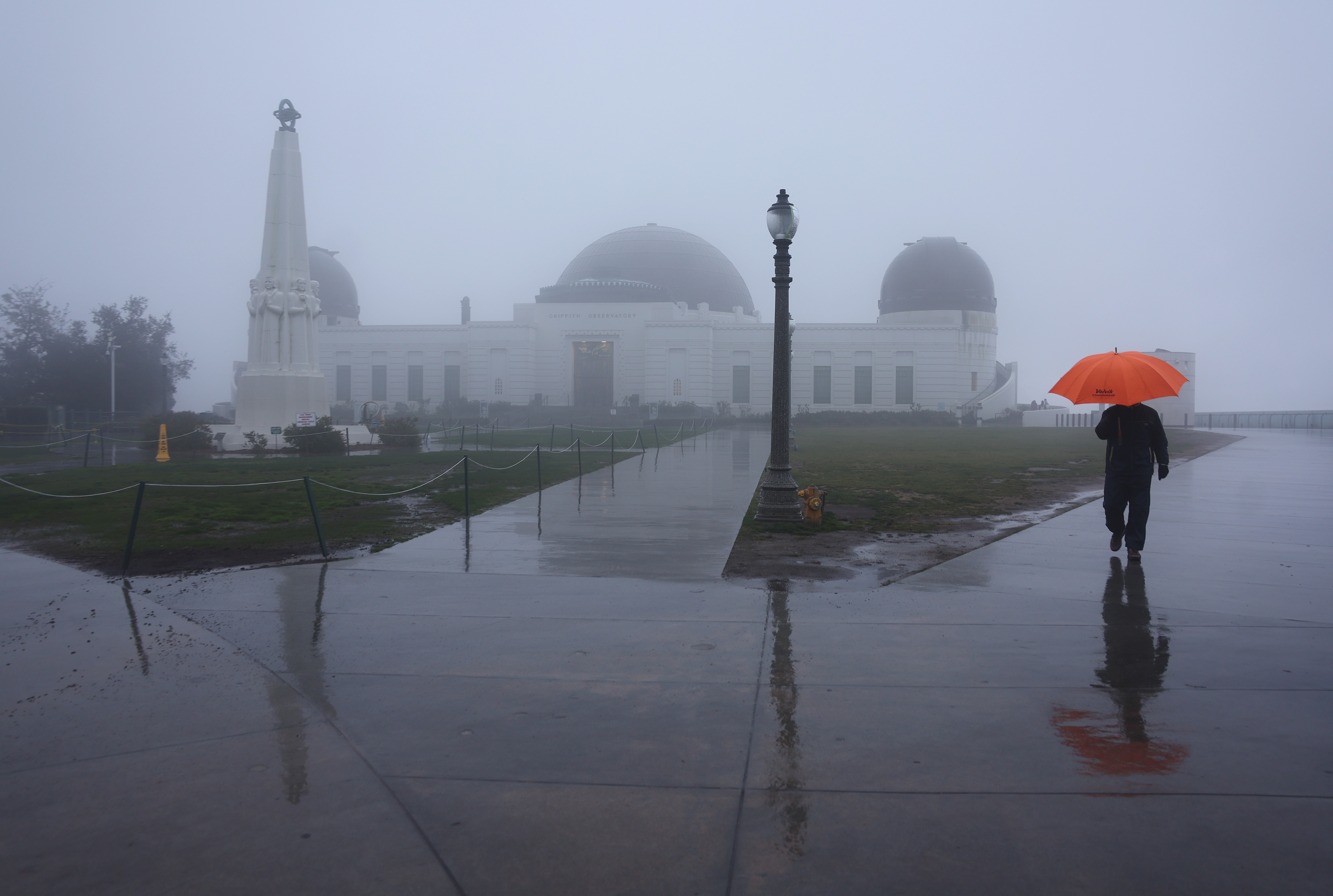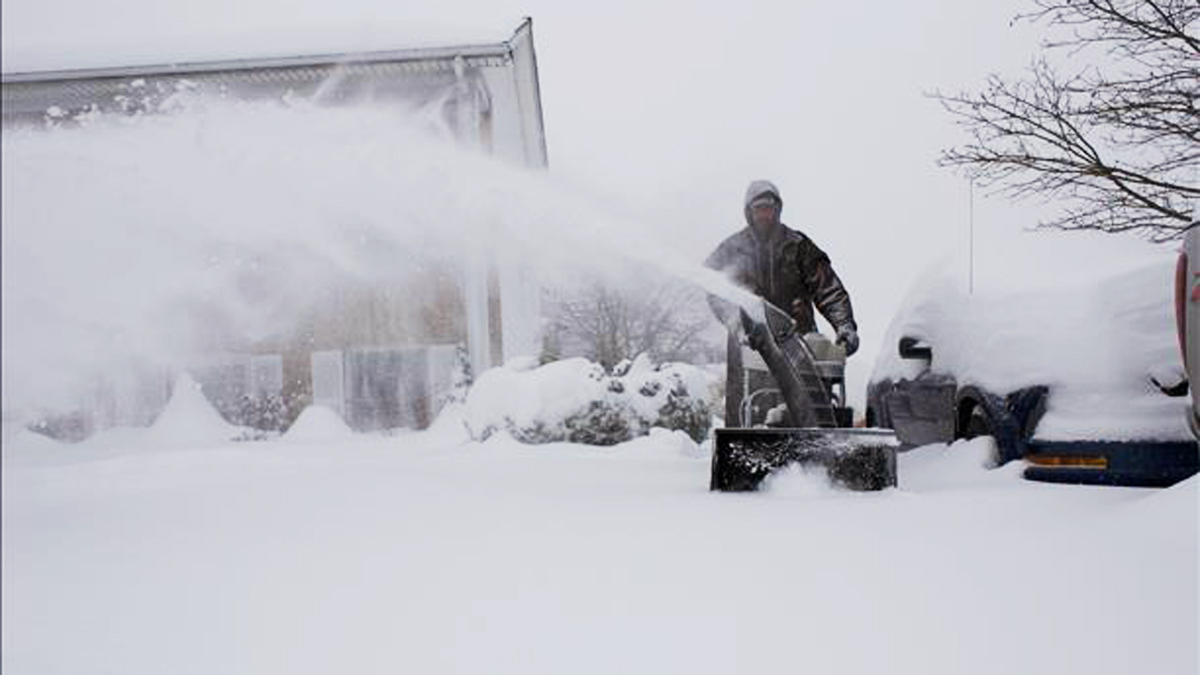Mountain communities still digging out from a late-February storm that brought historic snowfall face another threat Friday as a warmer system moves across the region.
Snow isn't the main concern with Friday's storm. Rain will fall in all mountain communities and resorts, which could combine with several feet of existing snow to cause problems, including roof collapses, increased avalanche danger and heavy runoff.
A flood watch is in effect for Southern California's mountains through Friday night. Flood advisories were issued through 7 p.m. for portions of Ventura and Los Angeles counties due to roadway flooding issues, as well as higher flows on streams, creeks, and washes.
Valeria Quevedo, dressed sleeveless in pink snow pants on a sunny Thursday in Crestline, was one of several residents clearing snow from a roof. Her strategy was to dig a pathway that would channel rainwater away from her home.
Get Southern California news, weather forecasts and entertainment stories to your inbox. Sign up for NBC LA newsletters.
Photos: SoCal Mountain Communities Stranded Amid Historic Snowfall
"We're just preparing for the rain," said Quevedo. "Trying to dig off the snow off the roof so it doesn't get too heavy."
The system will draw moisture from an atmospheric river over the ocean. The long plumes of moisture contributed to some of California's most powerful storms on record, including the system that brought historic snowfall to Southern California's mountains and days of rain elsewhere.
Unlike the February cold storm when snow levels dipped to unusually low elevations, snow levels with this storm will remain well above 9,000 feet on Southern California's tallest peaks. Only a few peaks in the San Bernardino Mountains, where residents are still digging out from the previous snowstorm, will receive snow.

Unrelenting snow blocked roads and left some stranded residents running low on supplies in the mountains east of Los Angeles. Snow piled up to rooftops in Lake Arrowhead and other communities. In Crestline, the roof of a family owned grocery store collapsed under the weight of snow.
"What happens is the snow begins to melt and turns to ice," said Justin Correll, the PIO of the San Bernardino County incident management team. "It becomes very difficult to move."
Up to 2 inches of rain are likely in most mountain areas.
"That's normally not a problem, but we have that huge snowpack," said NBC4 forecaster Belen De Leon. "Crews up there have been plowing the streets, the driveways. So what's going to happen is that this rain is going to be channeled into these streets and driveways, and that's where we cold see some snowmelt, the runoff and some minor flooding.
"That, and the snow, is going to act like sponge. So the rain that falls on top of that snowpack can cause that snow to become even heavier."

The snowpack at high elevations is so solid that it will likely absorb rain, but elevations below 4,000 feet will see melting and water runoff. The California Department of Water Resources activated its flood operations center, Director Karla Nemeth said.
“All of this could contribute to significant runoff,” Nemeth said.
Mountain community residents were urged to be prepared because rivers and creeks can rise quickly.
An avalanche March 1 blocked a section of mountain road on Mount Baldy. Mount Baldy Resort tweeted that avalanches were reported in the Movie Slope area.
No injuries were reported.
The rapid flows of snow down a mountain kill more than 150 people worldwide each year, according to the National Weather Service.
Warning signs include cracks in the snow around feet or skis; a hollow feeling to the ground underfoot; 'whumping' sounds indicating that the snow is settling; heavy snowfall or rain in a 24-hour period; rapidly increasing temperatures; and patterns on the snow created by the force of powerful winds.
At least 12 people have died since storms have hit Southern California's San Bernardino County, the sheriff said earlier this week, noting that only one was a weather-related death.
Northern California Faces Brunt of March Storm
The storm will have more severe implications for Northern California, where heavy rain, strong winds, thunderstorms and the threat of flooding are possible in communities already hammered by earlier storms.
The flood threat will come from the combination of rain and melting of parts of the huge snowpack built in California's mountains by nine atmospheric rivers early in the winter and later storms fueled by a blast of arctic air.
The snowpack at high elevations is so massive it should be able absorb the rain, forecasters said. But elevations below 4,000 feet will see melting and runoff. At high elevations the storm was predicted to dump heavy snow, as much as 8 feet in some locations.
California's Sierra Nevada snowpack, which provides about a third of the state's water supply, is more than 180% of the average on April 1, when it is historically at its peak. Ideally, the snowpack melts in spring and summer, then runs off into the state's expansive water supply system.
So much snow has fallen in the Sierra and other mountain ranges that residents are still struggling to dig out days after earlier storms. Roofs collapsed, cars were buried and roads were blocked. Gov. Gavin Newsom declared emergencies in 13 of California’s 58 counties beginning March 1.
Previous storms powered by atmospheric rivers have already pushed Los Angeles past its seasonal rain average. Statewide, the most severe drought conditions have been wiped out.
The Associated Press contributed to this report.



